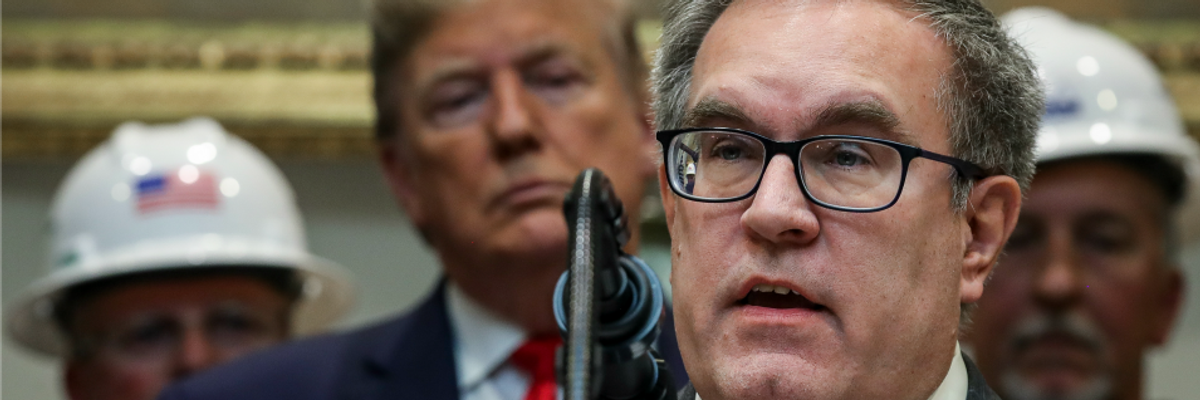Clear navigation for polluters
Fitting of the Trump administration, the "protection" in the rule's name doesn't really have anything to do with water. Not when it will reportedly remove half of the nation's wetlands and nearly 20 percent of streams from protection. It cannot be about water when the administration excludes from regulation other potential aquatic transporters of toxic chemicals, such as groundwater, rivers that run only during rainfall (a huge feature of the arid West), waste treatment systems, ditches, and ponds and depressions related to mining and construction.
The Trump rule is designed to allow oil and gas producers, chemical makers, agricultural interests, and developers to navigate a federal water regulatory world cleared of permits and penalties for pollution, a world not seen since the 1960s.
No, the Trump rule is designed to allow oil and gas producers, chemical makers, agricultural interests, and developers to navigate a federal water regulatory world cleared of permits and penalties for pollution, a world not seen since the 1960s. It flies in the face of a 2018 study by researchers at the University of California, Berkeley and Iowa State University that found that the 1972 Clean Water Act "has driven significant improvements" in water quality. The study reminded readers, "These investments have large costs but could have larger benefits. In the early 20th century, water-related mortality like cholera and typhoid killed tens of thousands of people every year. At the same time, regular fires occurred on many US rivers."
That past was not on the mind of EPA Administrator Andrew Wheeler when he unveiled the rule to several rounds of applause at the National Home Builders Association show in Las Vegas. In a press release, Wheeler said the new rule assured "regulatory certainty and predictability for American farmers, landowners and businesses to support the economy and accelerate critical infrastructure projects."
Wheeler offered no such certainty or predictability for the welfare of mothers and children drawing a drink from the faucet, nor for cities that need wetlands as a buffer against storms, not to mention the threat of floods, dangers to wildlife, or the outdoor recreation, fishing and hunting industries. Instead, he boasted that EPA rollbacks of regulations under Trump, which are among the nearly 100 environmental rollbacks being tallied by the New York Times, have saved American businesses $6.5 billion.
But as I have previously pointed out such claims of saving businesses from regulatory costs are nothing compared with the benefits of clean water. For instance, there is the $400 billion annual national outdoor recreation economy and the $9.5 billion annual economic output provided by jobs in clean water mitigation. Wildlife recreation alone, according to the Trump administration, involves more than 103 million Americans and pumps $157 billion into the economy in fishing, hunting, birdwatching, and photography.
Against all scientific sense
Wheeler, a former coal lobbyist, not only went against dollars and cents in pleasing his fellow polluters, he went against all scientific sense. In 2015, the EPA, in a review of 1,200 publications in peer-reviewed scientific literature, determined that:
- "Streams, regardless of their size or frequency of flow, are connected to downstream waters and strongly influence their function."
- Wetlands, even when they do not seem connected on the surface, "provide physical, chemical, and biological functions that could affect the integrity of downstream waters."
- "Incremental contributions of individual streams and wetlands are cumulative across entire watersheds."
Last week, the Public Employees for Environmental Responsibility (PEER) and 44 former scientists and administrators of government environmental and conservation agencies wrote the EPA Acting Inspector General Charles Sheehan to say that the Trump EPA has violated scientific integrity policies by ignoring the "Herculean" 2015 review of 1,200 studies. PEER, which has cited internal EPA documents indicating that the new rules might exclude at least 1.35 million miles of streams and more than 40 million acres of wetlands from protection said in the letter:
"The final Rule contradicts the overwhelming scientific consensus on the connectivity of wetlands and waters, and the impacts ephemeral streams and so-called "geographically isolated" wetlands have on downstream waters." The letter also said that the EPA did not consult with regional experts, did not allow those experts to formally register dissenting opinions, and "failed to disclose the potentially adverse impacts the final Rule will have on human health and the environment."
Scientists have long tried to impress these points upon the current administration. At the very beginning of the rollback of the Waters of the United States rule, a coalition of expert groups including the Society of Wetland Scientists, the American Fisheries Society, the American Institute of Biological Sciences, the Ecological Society of America, the Phycological Society of America, the Society for Ecological Restoration, and the Society for Freshwater Science wrote:
"Wetlands provide many services that promote human well-being including economic and non-economic benefits. Foremost, they keep our streams, lakes, and groundwater cleaner by 'treating' urban and agricultural runoff; this treatment includes reducing the negative effects of pollutants, transforming harmful nitrates into harmless nitrogen gas, trapping sediment, and removing pathogens.
They store water, and thus are a source of water during times of drought. Many wetlands soak up runoff and floodwaters, which reduces peak flood-flows and avoids costly flood damage. Lastly, wetlands sustain essential habitat for wildlife, fish, and waterbirds to feed, nest, breed, spawn, and rear their young in 'productive nurseries.'. . .Like diamonds, they can be small, but extremely valuable."
Last but not least, the EPA's own Science Advisory Board recently slammed Wheeler's process--to his face.
In a draft letter the board said the EPA ignored:
- The 2015 review of 1,200 studies that "emphasizes that 20 functional connectivity is more than a matter of surface geography"
- That "chemical or biological contamination of ground water may lead to contamination of functionally connected surface water"
- That irrigation canals from vegetable farms can carry E. coli and canals from confined feeding operations can be contaminated with chemicals such as steroids
The board said in summary that it was "disappointed" that Wheeler's rule "is not fully consistent with established EPA recognized science," and may not be consistent with objective of the Clean Water Act to "restore and maintain the chemical, physical and biological integrity of the Nation's waters."
If the Trump administration's own scientific advisory board, a host of biological societies, and scores of former government agency officials are disappointed, the rest of America should be fearful and angry.
Muhammad Ali once said, "Rivers, lakes, ponds, streams, oceans all have different names, but they all contain water." He was referring to many religions believing in a god. The Trump administration may claim that rivers, lakes, ponds, streams and oceans have different levels of protection, but the end result is obvious: all of them will contain more pollutants.


